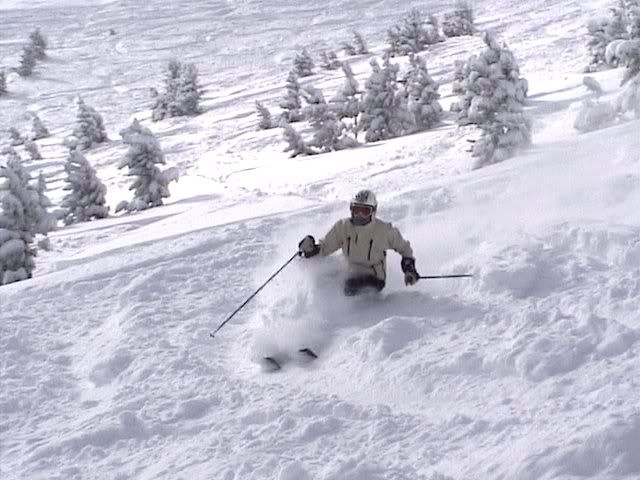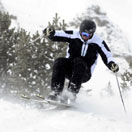As far as foot management in crud goes ... first, it doesn't count as crud if your skis are always on top ... it's not deep enough. But I've tried things along what you are suggesting. For example, the weighted release. ANd I still will sometimes if it gets very stiff. But HH said that wasn't the way to go; instead, trust in your technique. And sure enough, I've found the classic phantom (with the tail lifted plus pullback) to work stupid good in crud. Not so much necessary in pure powder.
Generally in deeper stuff your legs can't get too far away from you so CB is less significant. But CA, on the other hand, plays a more significant role and must be carefully yet strongly applied because the high-C is so important in bad snow. Why? Because with the high-C you can get a turn going real good early rather than using desperate measures closer to the fall line with little means to control your skis (i.e. the poor slobs using TT). Now, maybe you aren't in a go-for-broke totally-upside-down high-C position in crud, but you are definitely high-C-ing.
At least that's where I'm at right now. Plus I'm looking at far more snow in the back yard than there is at the mountain! Hell, maybe even my roof might have better base depth.
Question about control speed in high C
39 posts
• Page 2 of 3 • 1, 2, 3
Re: Question about control speed in high C
NoCleverName wrote:And sure enough, I've found the classic phantom (with the tail lifted plus pullback) to work stupid good in crud.
Depends on what type of crud one is skiing. For example, if I'm skiing classic PNW crud then most of the time I'll be using a two footed release.
NoCleverName wrote:Generally in deeper stuff your legs can't get too far away from you so CB is less significant.
That would depend on the skier. Most advanced skiers will need plenty of CB in deeper conditions because they develop significant angles.
Here's a shot of Diana in deeper pow - note the CB.

-

Max_501 - Posts: 4124
- Joined: Thu Mar 10, 2005 7:39 pm
Re: Question about control speed in high C
Depends on what type of crud one is skiing. For example, if I'm skiing classic PNW crud then most of the time I'll be using a two footed release.
Yes, but you CAN do the two-footed release
-

NoCleverName - Posts: 452
- Joined: Fri Feb 13, 2004 9:56 am
- Location: Massachusetts
Re: Question about control speed in high C
Am I correct that maximum high C speed control results from keeping the stance ski flat until the fall line, as in the description of the TFR in Book 2? This would seem to allow the shortest radius turn. At the other end of the spectrum, would the pure carved high C, with early edge engagement, have a larger radius and less speed control?
- rwd
- Posts: 87
- Joined: Sun Mar 22, 2009 11:32 am
Re: Question about control speed in high C
rwd wrote:Am I correct that maximum high C speed control results from keeping the stance ski flat until the fall line, as in the description of the TFR in Book 2?
A ski that is on edge and brushing across the snow creates more friction and is slower than a flat ski.
-

Max_501 - Posts: 4124
- Joined: Thu Mar 10, 2005 7:39 pm
Re: Question about control speed in high C
Max_501 wrote:rwd wrote:Am I correct that maximum high C speed control results from keeping the stance ski flat until the fall line, as in the description of the TFR in Book 2?
A ski that is on edge and brushing across the snow creates more friction and is slower than a flat ski.
Max, do you mean the stance ski is brushing on its LTE or its BTE?
- rwd
- Posts: 87
- Joined: Sun Mar 22, 2009 11:32 am
Re: Question about control speed in high C
When making a BPST the new stance ski will be up on edge, and brushing across the snow, during the high C.
-

Max_501 - Posts: 4124
- Joined: Thu Mar 10, 2005 7:39 pm
Re: Question about control speed in high C
Max_501 wrote:When making a BPST the new stance ski will be up on edge, and brushing across the snow, during the high C.
When you say "up on edge" do you mean tipped to the big toe edge? My understanding, from watching the brushed carve video, is that brushing the high C would be done with a softened LTE (4th toe). Once you've tipped to the BTE, wouldn't the ski want to carve rather than brush? Thanks.
- rwd
- Posts: 87
- Joined: Sun Mar 22, 2009 11:32 am
Re: Question about control speed in high C
rwd wrote:Once you've tipped to the BTE, wouldn't the ski want to carve rather than brush?
No.
See this post for detail - How to Brush
And see the answers to your similar question from 2012 from Geoff and HH.
viewtopic.php?f=1&t=3759&p=38290#p38290
-

Max_501 - Posts: 4124
- Joined: Thu Mar 10, 2005 7:39 pm
Re: Question about control speed in high C
Max_501 » Sun Feb 15, 2015 6:25 pm
rwd wrote:
Once you've tipped to the BTE, wouldn't the ski want to carve rather than brush?
No.
See this post for detail - How to Brush
And see the answers to your similar question from 2012 from Geoff and HH.
viewtopic.php?f=1&t=3759&p=38290#p38290
rwd,
I get your confusion. In terms of degree of edging on the Brushed-Carve, Diana clearly presents it as a matter of "choice" throughout on the e-Video. I thought, like yourself, the video was the final word. But, either it isn't or we are missing something which I don't doubt for a moment. Anyway, I've read the suggested posts. There appears both agreement and differentiation in wording leading to what then appears as disagreement. By the way, the topic of Brushed-Carves seems to have more words attached to it than others and perhaps that is the problem. In any case, I was happy with the e-Video.
- RRT
- Posts: 75
- Joined: Thu Feb 14, 2013 7:15 pm
Re: Question about control speed in high C
RRT wrote:I get your confusion.
The Brushed Carving e-Video confirms the information in the links provided earlier so not sure where the confusion is coming from.
Here's the description of the e-Video which provides an easy to understand and concise description - NOTE that "flatter" does not mean "FLAT"!
Learning to choose the edge angle of the stance ski will give you complete control over your speed in any size turn. You can choose a higher edge angle in order to carve; you can choose a flatter stance ski in order to "brush off" some speed throughout the arc of the turn. Once you learn the edge control, the balance on the stance ski, and the dominance of free foot tipping from this video, you'll have much better control of your speed in a variety of conditions and turns.
-

Max_501 - Posts: 4124
- Joined: Thu Mar 10, 2005 7:39 pm
Re: Question about control speed in high C
If you understand the Phantom Drag, this is the Phantom Drag in a turn. Accelerator stance ski and brake on the little toe edge. It's designed to reduce the early and debilitating big toe edge dominance. It is also designed to make skiers aware of the need to change angles gradually, and progressively on the stance ski, to better control the initiation and the engagement, without railing the ski without control. Railing a ski is an unwanted action in short turns, especially on steep terrain.
-

h.harb - Posts: 7047
- Joined: Sat Feb 03, 2007 2:08 pm
- Location: Dumont, Colorado
Re: Question about control speed in high C
To learn proper control of the stance ski many skiers need to wake up to gradual progressive tipping. The video offers the method of how to learn progressive big toe edging depending on the arc, your speed, the snow and the steepness. So there is no perfect answer, it's situational. A TFR like in book 2 and my You tube video, are slow progressive releases without twisting. This is not the same rate of tipping you would use on a steep, crud slope, however the progressive nature of the big toe, compared to little toe tipping is comparable. Also the e-video offers opportunities to learn early tipping without early pressure on the stance ski.
-

h.harb - Posts: 7047
- Joined: Sat Feb 03, 2007 2:08 pm
- Location: Dumont, Colorado
Re: Question about control speed in high C
In powder, a ski "edge" doesn't engage the carving. The bottom of the ski against the snow creates a platform to deflect the ski, that is what makes the ski change direction or turn. You don't want to go for a big toe angle early. You want your body crossing the ski to create angles in this type of skiing.
In the second part of this video in crud, steep, I apply progressive angles, short turns, no big toe dominance or hard edge sets. The e-video you are all referring to, allows you to develop these abilities.
In the second part of this video in crud, steep, I apply progressive angles, short turns, no big toe dominance or hard edge sets. The e-video you are all referring to, allows you to develop these abilities.
-

h.harb - Posts: 7047
- Joined: Sat Feb 03, 2007 2:08 pm
- Location: Dumont, Colorado
Re: Question about control speed in high C
h.harb wrote:To learn proper control of the stance ski many skiers need to wake up to gradual progressive tipping. The video offers the method of how to learn progressive big toe edging depending on the arc, your speed, the snow and the steepness. So there is no perfect answer, it's situational. A TFR like in book 2 and my You tube video, are slow progressive releases without twisting. This is not the same rate of tipping you would use on a steep, crud slope, however the progressive nature of the big toe, compared to little toe tipping is comparable. Also the e-video offers opportunities to learn early tipping without early pressure on the stance ski.
Thanks so much for all the feedback. I guess I was looking for a strategy, for when the terrain becomes more difficult, steep, narrow, etc. I understand now that I should continue to tip the free foot quickly and far, but with a relatively delayed stance ski tipping. As the terrain eases up, I can then let the stance ski more closely follow the free foot tipping for a more carved turn.
- rwd
- Posts: 87
- Joined: Sun Mar 22, 2009 11:32 am
39 posts
• Page 2 of 3 • 1, 2, 3
Return to Primary Movements Teaching System
Who is online
Users browsing this forum: No registered users and 38 guests
